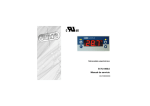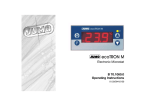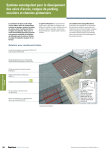Download Digital Thermostat B 70.1050.5.1 Operating Instructions
Transcript
Digital Thermostat B 70.1050.5.1 Operating Instructions 03.07 Overview of operation Contents 1 Identifying the instrument . . . . . . . . . . . . . . . . . . . . . . . . . . . . . . . . . . . . . . . . . . . . .2 2 Assembling . . . . . . . . . . . . . . . . . . . . . . . . . . . . . . . . . . . . . . . . . . . . . . . . . . . . . . . . . . . . . . 3 3 Electrical connection . . . . . . . . . . . . . . . . . . . . . . . . . . . . . . . . . . . . . . . . . . . . . . . . . . . . . . 4 3.1 Installation notes . . . . . . . . . . . . . . . . . . . . . . . . . . . . . . . . . . . . . . . . . . . . . . . . . . . . . . . . . . 4 3.2 Connection diagram . . . . . . . . . . . . . . . . . . . . . . . . . . . . . . . . . . . . . . . . . . . . . . . . . . . . . . . . 5 5 Operation . . . . . . . . . . . . . . . . . . . . . . . . . . . . . . . . . . . . . . . . . . . . . . . . . . . . . . . . . . . . . . 14 6 Technical data . . . . . . . . . . . . . . . . . . . . . . . . . . . . . . . . . . . . . . . . . . . . . . . . . . . . . . . . . . 15 6.1 Setup program . . . . . . . . . . . . . . . . . . . . . . . . . . . . . . . . . . . . . . . . . . . . . . . . . . . . . . . . . . . 18 7 Alarm messages . . . . . . . . . . . . . . . . . . . . . . . . . . . . . . . . . . . . . . . . . . . . . . . . . . . . . . . . . 19 Contents 4 Commissioning the instrument . . . . . . . . . . . . . . . . . . . . . . . . . . . . . . . . . . . . . . . . . . . . . . 6 4.1 Displays and controls . . . . . . . . . . . . . . . . . . . . . . . . . . . . . . . . . . . . . . . . . . . . . . . . . . . . . . . 6 4.2 Setting the instrument functions (parameter level) . . . . . . . . . . . . . . . . . . . . . . . . . . . . . . . . . 7 4.3 Allocating user rights (enabling level) . . . . . . . . . . . . . . . . . . . . . . . . . . . . . . . . . . . . . . . . . . 13 1 Identifying the instrument The nameplate with the order code is affixed to the side of the instrument. The supply voltage connected must correspond to the voltage specified on the nameplate. All necessary settings are described in these Operation Instructions. However, if any difficulties should still arise during start-up, you are asked not to carry out any unauthorized manipulations on the unit. This could endanger your rights under the instrument warranty! Please contact the nearest subsidiary or the head office in such a case. Please read these operating instructions before commissioning the instrument. Keep the manual in a place that is accessible to all users at all times. Please assist us to improve these operating instructions, where necessary. (1) Basic version 701050/ 8 9 1 2 3 4 eTRON T factory-set, configurable customized configuration (2) Measurement input Pt100 in 2-wire circuit Pt1000 in 2-wire circuit KTY2X-6 Fe-Con J Fe-Con L NiCr-Ni K 0(4) — 20 mA 0 — 10 V 1 relay, changeover 10A 230V 1 (3) Supply 02 230V AC +10/-15% 48 — 63Hz 05 115V AC +10/-15% 48 — 63Hz 31 12 — 24V DC +15/-15% / 24V AC +15/-15%, 48 — 63Hz 1 Identifying the instrument H factory-set Included in delivery: 1 Operating Instructions 70.1050.0 2 Assembling Disassembling °C 0 (1) (2) 2 Assembling 55 90 2 ≤ 75 3 3 Electrical connection 3.1 Installation notes - - - The instrument is not suitable for installation in areas with an explosion hazard and must be built into a housing that provides protection against fire /electrical hazards. Apart from faulty installation, incorrect settings on the instrument (setpoint, parameter level data) may also affect the proper functioning of controlled processes or lead to damage. Provision should therefore always be made for safety devices that are independent of the instrument, e. g. overpressure valves or temperature limiters/monitors. Adjustment must be restricted to specialist personnel (lock parameters for operation). Please observe the corresponding safety regulations in this matter. Unfavorable parameter adjustment may result in unstable control. The process value obtained should therefore be monitored for its stability and knowledge about the process should be obtained. The load circuit must be fused for the maximum relay current in order to prevent welding of the output relay contacts in the event of a short circuit. Do not connect any additional loads to the supply terminals of the instrument. The external fuse of the supply should not be rated below 1A, depending on the conductor cross-section. If contact with live components is possible while working on the instrument, it must be disconnected on both poles from the supply (via a separate mains supply switch, for instance). Supply Measurement input and supply 230V AC and 115V AC short-circuit-proof electrically isolated from each other 12 — 24V DC and 24V AC not short-circuit-proof not electrically isolated from each other 3 Electrical connection - - The choice of cable, the installation, the fusing and the electrical connection must conform to the requirements of VDE 0100 “Regulations on the Installation of Power Circuits with nominal voltages below 1000 V” or the appropriate local regulations. The electrical connection must only be carried out by qualified personnel. Electromagnetic compatibility conforms to the standards and regulations listed under Technical data. 4 3.2 Connection diagram The electrical connection must only be carried out by specialist personnel! 3 Electrical connection V 5 4 Commissioning the instrument 4.1 Displays and controls 3-digit 9-segment display, 6 mm high, and symbols for the temperature unit LED K1 LED K1 lights up when the relay is energized. LED K1 goes out when the relay is de-energized. Keys programming increase value select operational status at enabling level decrease value select operational status at enabling level Setup interface The instrument is linked to a PC via a PC interface with TTL/RS232 converter and adapter (3-pole pins). h Connect supply voltage – all segments light up twice as a test (segment test). When everything has been connected up correctly on the instrument, the present process value will be shown. If an alarm message appears, see Chapter 7 “Alarm messages”. 4 Commissioning the instrument LC display The relay operates according to the controller type that was set, see Chapter 4.2 “Setting the instrument functions (parameter level)”. 6 4.2 Setting the instrument functions (parameter level) Time-out If no key is pressed for 60 seconds, the instrument automatically switches back to process value display, see Overview of operation on the first inside page. The instrument functions and values are set at the parameter level. h Press for 3 seconds and will appear alternately. h Set code 72 for accessing the parameter level by using the The longer the key is pressed, the faster the value will change. h Acknowledge with , parameter name and value appear alternately, e.g. and keys. . h Set value within the specified value range by using the and keys. h Acknowledge settings with . h Set next parameter, see Overview of operation on the first inside page. H Switching parameters out of display: The table below lists all the parameters for each instrument type. Depending on the type designation on the nameplate, parameters which are not required can be hidden. 4 Commissioning the instrument H 7 Controller Parameter Value range from...factory-set...to Setpoint SP.L ... 0.0 ... SP.H target value of control action (temperature value, current or voltage). Hysteresis 0.2 ... 1.0 ... 99.9 Low setpoint limit SP can be set up to this low limit. -999 ... -50 ... +999 High setpoint limit SP can be set up to this high limit. -999 ... 500 ... +999 Controller type : cooling controller : heating controller , 4 Commissioning the instrument Meaning 8 Parameter Value range from...factory-set...to Meaning 0 ... 60min Minimum ON time 0 ... 999 s Minimum OFF time Here you can set the time for which the equipment unit, for instance, has to remain switched on or off. These values depend on the heating or cooling 0 ... 999 s unit being used (observe manufacturer’s specifications). In the event of a probe error, the relay is operated immediately as set in parameter S.Er. Alarms Low alarm limit -999 ... -200 ... +999 As soon as the process value falls below this limit, the alarm message is displayed, see Chapter 7 “Alarm messages”. High alarm limit -999 ... 500 ... +999 As soon as the process value goes above this limit, the alarm message is displayed, see Chapter 7 “Alarm messages”. Alarm hysteresis 0.2 ... 1.0 ... 99.9 The hysteresis that was set is below Alarm suppression time An alarm from or present for longer than or above . 0 ... 60 min 4 Commissioning the instrument Switch-on delay after power-on for staggered switch-on of several equipment units. is not displayed for this time. If an alarm is , then it will be displayed. 9 Parameter Meaning Value range from...factory-set...to 0, 1 Sensor connected in 2-wire circuit Pt100: Pt1000: KTY2X-6: or Input Measurement input group 1 on Type: 701050/X1X-1-XX Measurement input group 2 on Type: 701050/X2X-1-XX Fe-Con J: Fe-Con L: NiCr-Ni K: or Measurement input group 3 on Type: 701050/X3X-1-XX 0(4)... 20 mA: / Measurement input group 4 on Type: 701050/X4X-1-XX 0 ... 10 V: / Start value for indication range with measurement input voltage or current. -999 ... 0... +999 Example: input signal (e.g. 4 — 20mA) is to be represented on the display from -10 to 50. Setting: S.cL= -10 and S.cH=50. End value for indication range with measurement input voltage or current -999 ... 100... +999 Signal for measurement input current: 0 = 0 — 20mA 1 = 4 — 20mA 0, 1 4 Commissioning the instrument Response to over/underrange 0: relay de-energized 1: relay energized 10 Parameter Meaning -99.9 ... 0.0 ... 99.9 Lead compensation resistance 0.0 ... 0.0 ... 99.9 in Ω This value is used for compensating the resistance of the probe lead for resistance sensors and is dependent on the lead length. For best temperature measurement results, the resistance value of the probe lead has to be entered here. A If the total resistance at the measurement input (sensor resistance + selected value for OF.r) exceeds 320 Ω with Pt100 or 3200 Ω with Pt1000/KTY2x-6, a measurement error will occur ! Unit for the indicated process value A For settings in °F, the process value will be converted correspondingly. All other setting, such as for SP, will retain their values. °C, °F or no (= no unit) 4 Commissioning the instrument Process value offset process value offset in °C, °F or digit (no unit) Value range from...factory-set...to 11 Parameter Value range from...factory-set...to Meaning H Return to the first parameter SP of the parameter level by pressing > 3 sec. 4 Commissioning the instrument Filter time constant 0.1 ... 0.8 ... 99.9 s For adapting the digital input filter. At a signal step, 63% of the changes are registered after the filter time constant has elapsed. Values between 0.1 and 0.7 are interpreted as 0.8 (sampling time). If the filter time constant is long: - high damping of interference signals - slow reaction of the process value display to process value changes 12 4.3 Allocating user rights (enabling level) The setting at the enabling level defines user rights which determine whether a parameter is shown at the operating level, can be edited or is not shown at all. for 3 seconds and appears. h Set code 82 for accessing the enabling level using and . h Acknowledge with Parameter and User rights blink in alternation e. g. h Use the and keys to set user right User right , . or . Display Factory setting Parameter can be edited Parameter is shown - Parameter is not shown all other parameters h Acknowledge settings with . h Set next parameter, see Overview of operation on the first inside page. 4 Commissioning the instrument h Press 13 5 Operation 5 Operation 14 6 Technical data Meas. input Designation Range Meas. accuracy1/ ambient temperature error Recognition of ... Probe shortcircuit Probe break 0.1%/ ≤100ppm/°C yes yes 0.1%/ ≤100ppm/°C yes yes KTY2X-6 (PTC) -50 to +150 °C 1%/ ≤100ppm/°C yes Resistance 0 — 3000 Ω customer table 3 0.1%/ ≤100ppm/°C 3 = 0Ω yes yes Measuring current with Pt100: 0.2 mA, with Pt1000, KTY2X-6 and resistance: 0.02 mA Lead compensation is settable via the parameter Lead compensation resistance . Total resistance (sensor+lead) must not exceed 320Ω with Pt100 and 3200Ω with Pt1000, KTY2X-6 and resistance. Thermocouples Fe-Con J EN 60 584 -200 to +999 °C 0.4%/ ≤100ppm/°C 2 no yes Fe-Con L DIN 43 710 -200 to +900 °C 0.4%/ ≤100ppm/°C 2 no yes NiCr-Ni K EN 60 584 -200 to +999 °C 0.4%/ ≤100ppm/°C 2 no yes -10 to 60 mV customer table 3 0.1%/ ≤100ppm/°C 3 no yes 6 Technical data -200 to +600°C -200 to +600°C Resistance Pt100 EN 60 751 thermometer Pt1000 EN 60 751 For the voltage input (-10 to 60 mV), the terminal temperature compensation for thermocouples can be used. Internal terminal temperature compensation can be switched off through the setup program (0°C). 15 Meas. input Current Designation Range Meas. accuracy1/ ambient temperature error Recognition of ... Probe shortcircuit Probe break -2 to 22 mA scalable with and or customer table 0.1%/ ≤100ppm/°C 3 no no 4 to 20 mA 2.4 to 21.6 mA scalable with and 0.1%/ ≤100ppm/°C 3 yes yes -1 to 11 V scalable with and or customer table 0.1%/ ≤100ppm/°C no Input resistance RIN ≤ 3Ω Voltage 0 — 10 V no Input resistance RIN ≥ 100kΩ 1.) The accuracy refers to the measuring range span. 2.) valid from -50°C 3.) A valid customer table must be entered through the setup program and switched over to This may reduce the measuring accuracy. 6 Technical data 0 to 20 mA in the instrument. Ambient conditions Ambient temperature range Storage temperature range Climatic conditions 0 to +55°C, with side-by-side mounting: 0 to +40°C -40 to +70°C ≤ 75% rel. humidity, no condensation 16 Output Relais K1 (changeover contact) 150,000 operations at 10A/250V AC 50Hz resistive load 800,000 operations at 3A/250V AC 50Hz resistive load Supply Supply voltage Housing Material Mounting Operating position Weight Protection Flammability class polycarbonate DIN rail 35mm x 7.5mm to EN 50 022 unrestricted approx. 110g IP20 UL 94 V0 6 Technical data Power consumption 230V AC +10/-15%, 48 — 63Hz or 115V AC +10/-15%, 48 — 63Hz (isolated from measurement input) 12 — 24V DC +15/-15%, 24V AC +15/-15%, 48 — 63Hz (not isolated from measurement input) < 2VA Electrical data Data backup Connection Electromagnetic compatibility interference emission immunity to interference Electrical safety EEPROM screw terminals for wire cross-sections up to 2.5 mm2 EN 61 326 Class B to industrial requirements EN 61 010, Part 1, overvoltage category III, pollution degree 2 17 6.1 Setup program The program and the interface with adapter are available as accessories and offer the following advantages: - simple and convenient parameterization and archiving from a PC - simple duplicating of parameters on instruments of the same type - possibility of entering a linearization table - PC Pentium 100 or compatible - 128 MB RAM, 16 MB free on hard disk - CD-ROM drive - free COM interface - Microsoft Windows 98/ME/NT4.0/2000/XP h Link PC interface to the RS232 interface on the PC h Insert black adapter (3-pole pins) into the side of the instrument 6 Technical data Minimum hardware and software requirements: 18 7 Alarm messages The following alarm messages can be shown in the temperature display: Error message Elimination - Check sensor and connecting cable for damage or short-circuit - Check whether the correct sensor has been set or connected Display underrun The measured value is too small and is outside the range. Time for switch-on delay after power-on has elapsed. With display over/underrun, the switch-on delay becomes ineffective. Value has fallen below the low alarm limit v Chapter 4 “Commissioning the instrument” H These messages are only output to the temperature display. h Cancel switch-on delay with + h Depending on the controller type, check whether the heating or cooling unit functions faultlessly. 7 Alarm messages Cause Display overrun The measured value is too large and outside the range. h Check whether the installed relay fuse is still in Value has gone above the high alarm limit good working order. The alarm disappears as soon as the process value goes above or below the AL limits by the amount of the hysteresis. 19 BELGIË / BELGIQUE SERBIA AND MONTENEGRO Tel. +381 230 401 770 Fax +381 230 401 770 [email protected] SCHWEIZ / SUISSE Tel. 0800 551308 Fax 0800 551309 [email protected] LIETUVA/LATVIJA/EESTI MAGYARORSZÁG Tel. +36 1 253 7617 Fax +36 1 253 7618 [email protected] ČESKÁ REPUBLIKA Tel. +420 241 009 215 Fax +420 241 009 219 [email protected] WWW.THERMAL.PENTAIR.COM THERMAL MANAGEMENT SOLUTIONS © 2013 Pentair. All Pentair trademarks and logos are owned by Pentair or its global affiliates. Pentair reserves the right to change specifications without prior notice. REPUBLIC OF KAZAKHSTAN Tel. +7 495 926 18 85 Fax +7 495 926 18 86 [email protected] HRVATSKA Tel. +385 1 605 01 88 Fax +385 1 605 01 88 [email protected] UNITED KINGDOM Tel. 0800 969013 Fax 0800 968624 [email protected] POLSKA Tel. +48 22 331 29 50 Fax +48 22 331 29 51 [email protected] FRANCE Tél. 0800 906045 Fax 0800 906003 [email protected] TÜRKIYE Tel. +90 530 977 64 67 Fax +32 16 21 36 04 [email protected] ÖSTERREICH Tel. 0800 297410 Fax 0800 297409 [email protected] ESPAÑA Tel. +34 902 125 307 Fax +34 91 640 29 90 [email protected] SVERIGE Tel. +46 31 335 58 00 Fax +46 31 335 58 99 [email protected] NORGE Tel. +47 66 81 79 90 Fax +47 66 80 83 92 [email protected] DEUTSCHLAND Tel. 0800 1818205 Fax 0800 1818204 [email protected] SUOMI Puh. 0800 11 67 99 Telekopio 0800 11 86 74 [email protected] NEDERLAND Tel. 0800 0224978 Fax 0800 0224993 [email protected] DANMARK Tel. +45 70 11 04 00 Fax +45 70 11 04 01 [email protected] BULGARIA Tel. +370 5 2136633 Fax +370 5 2330084 [email protected] РОССИЯ Тел. +7 495 926 18 85 Факс +7 495 926 18 86 [email protected] ITALIA Tel. +39 02 577 61 51 Fax +39 02 577 61 55 28 [email protected] Tel./fax +359 56 86 68 86 fax +359 56 86 68 86 [email protected] Tel. +32 16 21 35 02 Fax +32 16 21 36 04 [email protected]
































